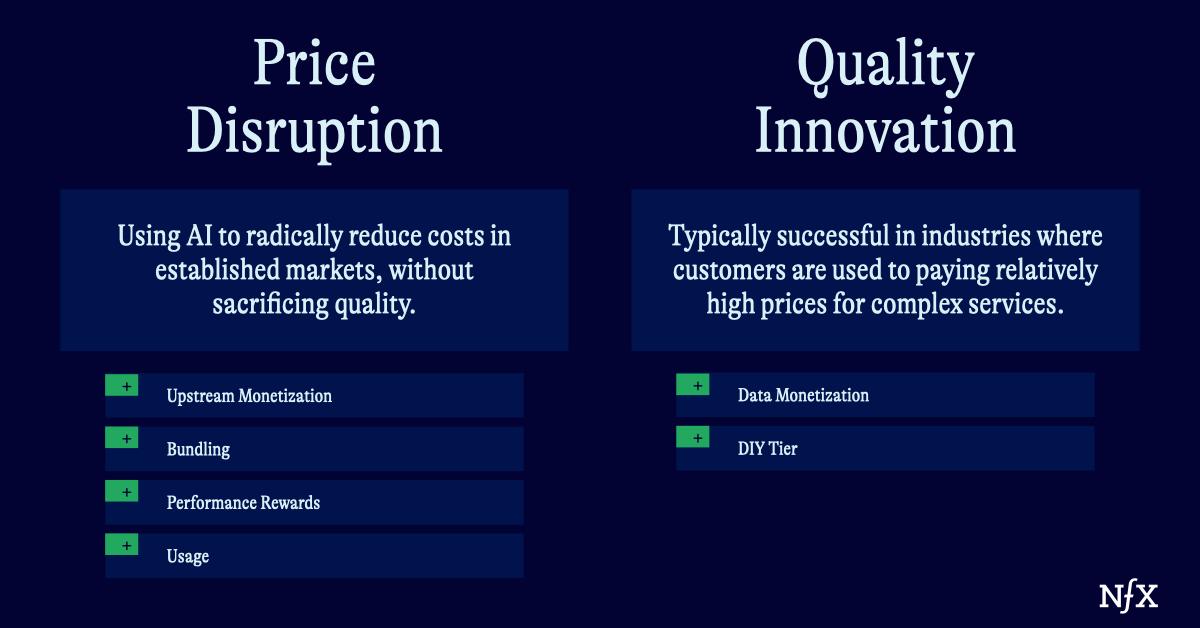

Building a great startup isn’t just about breakthrough technology. It’s about relentlessly reimagining how you create, deliver, and capture value.
It’s a lesson that many AI companies are only beginning to learn. We’re now several years into the AI era. Many consumer AI apps have experienced a high velocity, low retention dynamic. Many go viral, and grow because of high demand, but struggle to retain users. Competition remains high and ever growing. There are now likely 4 or 5 other AI companies operating in your vertical.
And interestingly, many “AI founders” are struggling with monetization, or, at least, not placing the concept front and center. A recent survey suggested that only 58% of startups that had created a generative AI product had actually monetized that product.
The founders that win won’t just build impressive AI products – they’ll architect complete business model strategies that compound value. They’re building better businesses.
When it comes to business models, startups need to begin with a singular focus: know exactly how you’re going to capture customer mind share and deliver value quickly. But you should always have an eye toward the long-term: how can you stack business models over time in a way that increases revenue per customer, increases net revenue retention, decreases churn, and truly captures the full opportunity in front of you?
The best companies are constantly doing this: Spotify began with subscription streaming and layered in podcasts, advertising, and data insights. ChatGPT combines subscriptions and usage fees.
Especially in the AI era, we are encouraging our companies to get creative about business models. The key is to develop a system that’s stackable, remixable…flexible enough to grow alongside your business.
The Bare Bones of Business Model Innovation
Again, the core job of a startup is to innovate on business models.
As others have pointed out, it’s very rare to see someone completely recreate the wheel when it comes to business models. The innovation comes from combining many of these models to create something new. You can fuse two of these models together. You can subvert one dominant business model to gain market share from an incumbent competitor. You can layer models on top of one another as you build out product capabilities. And more.
As you add each layer to your business model, you want to focus on four criteria:
- How can I leverage my existing capabilities?
- Where can I add new value streams?
- Can I increase customer retention?
- Can I reduce the costs of adding new services?
Amazon, for example, sells data, charges for usage (via AWS) and runs advertising. More recently, we’ve seen OpenAI monetize ChatGPT via API via token usage, and collect a monthly subscription from consumers. A subversion and layering example: Robinhood introduced non-commission trading, and the ability to buy fractional shares. These business model innovations ran counter to the brokerage fees. From there, they’ve introduced a series of new revenue streams as they capture more of the traditional “banking” experience.
You could imagine an AI company that begins with an AI-powered software tool, monetizing via pay-per-seat, or subscription. You could then add API access to your AI capabilities, and charge for that usage. As your model matures, you could offer custom model training services in your vertical. Or, eventually, full-stack consulting and implementation services.
Each new offering offers a potential new revenue stream, leverages your expertise, and should, in theory, reduce the cost of adding new services.
We suggest startups begin with one product that generates the vast majority of your revenue. The hardest thing for startups to do in the early stages is find something that works and focus on it (we’ll outline two common starting points for companies in the AI era below). But the ability to think through this strategy will be critical later on.
The key is to examine how your business strategy builds upon itself as your company grows. If you do this correctly, you build a machine where your revenue growth will match your user growth –– the sign of a category leader.
There are truly thousands of different ways to combine existing business models to create something new for your company, and your industry. It’s just a matter of seeing the connections and building your strategy.
Here’s how we’re seeing this play out among AI companies recently…
AI Business Model Innovation
If we look at the historical arc of business model innovation for software, we’ve seen three major changes in the past few decades.
We moved from selling on-premise software, to selling software-as-a-service via pay-per-seat model, to usage-based fees. AI has forced another evolution. Most Generative AI pricing strategies are defaulting to either usage or the newer, “outcome-based fees” as a way to align payment with outcome and reduce wasted spend associated with a per seat model.
Within this shift we’ve seen two major innovation paths emerge: Price Disruption and Quality Innovation.
Price Disruption: using AI to offer services significantly cheaper than their incumbent or non-digital counterparts, leading to a broader customer base.
Quality Innovation: companies provide complex, premium services at scale with AI. Maintain the prices associated with quality services and instead use enhanced margin to win on customer acquisition.
These were the opening moves of the AI-era business model reimagination. They have potential to help capture market share quickly and, if executed fast, will work for a time.
But it’s how you follow these moves up that will determine defensibility and long-term success.


Opening Strategies: Price Disruption
At its core, Price Disruption uses AI to radically reduce costs in established markets, without sacrificing quality. This strategy works well if:
- An existing product is overly generic and has always been a poor fit for a specific industry (see our expanded thoughts on this in The Verticalization of Everything)
- The service itself is commoditized, and it’s hard to win on quality.
- Your major competition is a non-AI legacy system. This is more likely to happen in specific verticals.
If you can offer, say, the services of a traditional marketing or accounting firm (see The Rise of AI Agents), for less than the price of a firm on retainer, you will likely see initial success.
At the beginning of the AI era, we saw a number of companies initially succeed using this strategy.
That said, there is a potential for this to create a race to the bottom dynamic over time. It’s hard to imagine even large enterprises paying for services that are 10x the price of competitors over the long haul. In the worst case scenario, AI-services companies continually undercut one another to gain market share.
With this in mind, we see the most attractive opportunities in spaces where there is simply an insufficiently large labor pool to solve a specific problem and the speed of execution for AI vastly outstrips the speed of recruiting, training, and supervising a human worker. The AI solution is not only cheaper, but a better overall fit for the market.
That’s why, while Price Disruption is a powerful tool initially, it’s only an opening move. Consider pairing it with a tactic like:
- Price Disruption + Upstream Monetization
Begin by offering a very competitive price around a key control point – a pain point in your given industry, perhaps. Monetize later on via a marketplace or embedded fintech.
Most useful for: Industries with complex value creation chains –– where you can undercharge on one aspect of the chain, and make up the difference later on. (Think: logistics, real estate)
- Price Disruption + Bundling
Offer your core service at a competitive price, monetize later with “add-ons” that unlock additional value for the customer.
This may become a very attractive business model in the AI agent space. It’s been noted that many AI agent companies are in a “land grab” for tasks with measurable outcomes (which enables the pay-per-outcome model). The category winner in the “AI workforce” space will bundle many of these “jobs” together, allowing for economies of scale.
- Price Disruption + Performance rewards
Offer your core service at a low or competitive price. Earn more based on a job well done. For example, you offer the services of a branding or marketing agency at a low price thanks to AI automation, but charge royalties based on the success of the campaign.
- Price Disruption + Usage
Offer core service at a competitive price or even free. Then charge customers based on additional usage. For example, a company might offer a CRM for free, but then monetize based off of email send or usage.
Opening Strategies: Quality Innovation
Quality Innovation is typically successful in industries where customers are used to paying relatively high prices for complex services.
This is one of the reasons AI in the legal field is seen as a huge opportunity. But this dynamic exists in other spaces as well. Medical billing for example: You could imagine an AI-led service designed to simplify the process of coding bills more accurately, reducing liability, and reducing overhead.
You don’t win by offering a cheaper service. In fact, some customers may even be wary of a cheap service with such high stakes attached. Rather, you win through quality at scale. If you can provide a faster, smoother experience, you can still win customers over by simplifying a laborious process. You can charge the same price, but deliver a 100x better experience – a win for you, and the customer.
Your competitive advantage with this strategy lies in gross margins. If you can use AI to streamline the operations of say, a law firm that provides flat fee or success based services and reduce overhead costs, you gain a margin advantage over your competitors.
You then reinvest that margin into traditional marketing and awareness. You play the growth game with more dry powder at your disposal thanks to your competitors. This is unlikely to be a long term advantage as others adopt similar tools, but for fast moving start-ups it can be enough to build scale and find other forms of defensibility.
This strategy has more long-term defensibility than pure Price Disruption. But with these advantages in hand, consider adding:
- Quality Innovation + Data Monetization
Ideally, you have already gained access to industry-specific data, allowing you to provide a high-quality AI service. That flywheel will help you maintain your quality over time. You can also consider “walling off” sections of that data and selling access to that insight (especially if you gain more insights into a complex process).
- Quality Innovation + DIY tier
Offer a complete, high quality service initially at a high price – later graft on a slightly lower level “DIY” tier. For example, some users can pay less to access a non-AI assisted CRM, but over time, may convert to the AI-assisted high quality level.
Business Models, Defensibility, and Your Long-Run Success
Even in the AI space, where there is abundant capital, competition is fierce. Don’t confuse adoption of pilots with product market fit in a rapidly shifting market. Your path to raising a Series A and beyond will be increasingly dependent on your ability to both grow like a category leader and show that you have the fundamental business metrics (like a strong business models) to sustain that growth.
This is a step-change from several years ago, where the “growth at all costs” mentality reigned. Growth without the traction and revenue metrics to set it up isn’t enough. The best startups in their verticals are seeing increasing usage by each customer over time as the solution becomes more embedded in the workplace.
At NFX we are encouraging all of our founders to get strategic and creative about defensibility (there’s a reason NFX is our name). As we do these exercises, we find that so many forget about the business model as a key element of building this defensibility in the long run.
If you can crack this code early, you will be set up for long-term success. Even in an increasingly crowded market.
As Founders ourselves, we respect your time. That’s why we built BriefLink, a new software tool that minimizes the upfront time of getting the VC meeting. Simply tell us about your company in 9 easy questions, and you’ll hear from us if it’s a fit.


